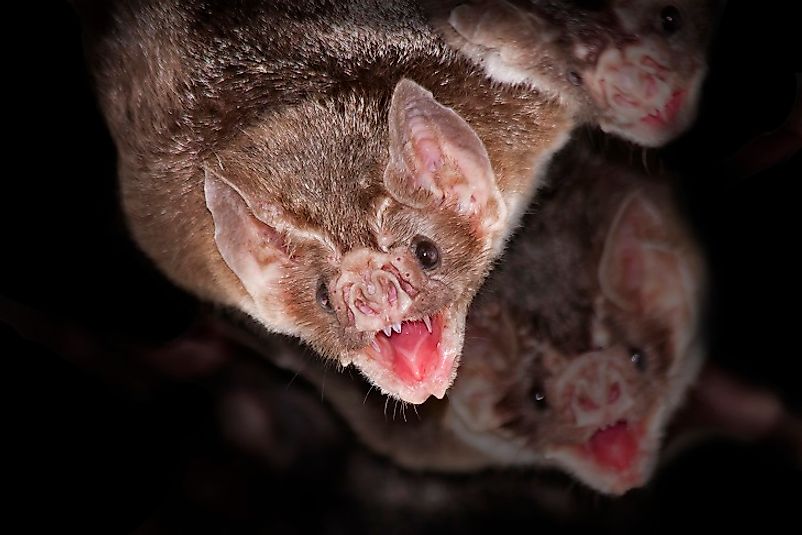Are Vampire Bats Really Real?

5. Physical Description and Subspecies
Since a long time ago, blood sucking vampires, the creations of local folklore, have been the subject of many examples of horror-centric literature, art, film and television series, wherein they have been depicted as undead beings who feed on the living essence (primarily in the form of blood) of other, living creatures. Though these characters are completely fictional, blood sucking vampire bats do exist in nature. Common vampire bats are tailless creatures with a length ranging between 7 and 9 centimeters, and varying even more in weight depending on the volume of blood consumed by the bat. The fur of the bat is short in length and ranges in color from brown to reddish-orange. Unlike other fruit bats, vampire bats are able to crawl, hop, and creep on the ground, possessing long first segments of the thumb. These bats also have short, conical muzzles, thermoreceptors in their noses, sharp front teeth for cutting purposes, and smaller rear teeth.
4. Habitat and Range
Three species of sanguivorous (blood-eating) bats inhabit the world today. Namely, these are the Common vampire bat (Desmodus rotundus), the White-winged vampire bat (Diaemus, or Desmodus, youngi), and the Hairy-legged vampire bat (Diphylla ecaudata). These bats are all native to the Americas, and are found from Mexico across Central America and south into the South American countries of Brazil, Chile, and Argentina.
3. Feeding Behavior
The vampire bats completely depend on other species' blood as their source of food. These bats are nocturnal in nature, and spend the daytime resting upside down in dark spaces like caves. More than 100 vampire bats will live close together in a single colony in such caves. At nighttime, these bats become active, and start flying around in search of prey. Domestic cattle and horses are often their prime targets, but other animals and, occasionally, humans might also become the victims of these blood-sucking bats. They approach their prey animals from the ground, moving on all fours until they come near their targets, who are usually fast asleep. They then use the heat-sensitive cells in their noses to sense out the warmth of a blood vessel near the surface of their target's body. The bat then prepares the site highly efficiently by clipping away the fur or feathers, licking the site with their tongue, and finally using their razor sharp teeth to pierce the victim’s blood vessels, drawing blood from the victim for about half an hour. The secretion of anticoagulants like draculin from the saliva of these bats prevents the blood from coagulating. Once done, the bat silently leaves its prey, and return back to its resting grounds. The victim usually survives the bat attack, as only a small volume of blood is lost. However, their bites might result in nasty infections if not properly treated.
2. Social Behavior
Even though we have learnt to associate vampire bats with evil creatures with a purely bloodthirsty nature, there are certain facts about these flying mammals which might make us reconsider our judgments of these animals. A study conducted by Gerald Wilkinson of the University of Maryland in College Park, Maryland, U.S.A. has revealed a completely different side of these vampire bats. Wilkinson and his colleagues have studied these bats for an extended period of time. They have found that after each meal of blood, the vampire bats would enlarge in size, becoming nearly double their original weight. However, when they started screening the bats on their way back to their roosting sites, they found that nearly one in ten adult bats, and one in three juveniles, went back hungry each night. The scientists knew that, if these bats starved for more that three days in succession, they would almost certainly die. However, what they noticed while studying the bat colonies was really dumbfounding. They observed that those bats who managed to get a full meal would return to the roost and regurgitate out blood to feed their family members, and even non-related “friends” who had been unable to feed on blood themselves that night. This generous nature of the vampire bats really amazed the scientists, who now started regarding the bats more highly for their community-oriented spirits.
1. Environmental Threats
Even though the vampire bats do appear to teach us lessons on social harmony and selfless sharing, traditional fears of bats have often led to a misunderstanding of these creatures, and their merciless persecution has often been seen wherever they have been discovered. The vampire bats have also become rarer due to the adverse effects of loss of habitat and climate change affecting so many of our world's species today. We need to understand that these creatures are quite harmless and, though rare cases of rabies have been linked to vampire bat bites, only 0.5% of these bats are believed to carry rabies, and most of the infected vampire bats are too disoriented from the viral infection to be able to fly. On the positive side, the anticoagulant properties of the saliva of the common vampire bat have been harnessed to generate a genetically-engineered drug called desmoteplase, that has been used in the treatment of stroke patients. A study on desmoteplase was published in 2003 in Stroke: Journal of the American Heart Association.











